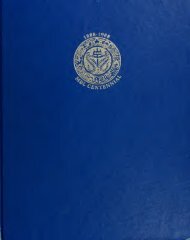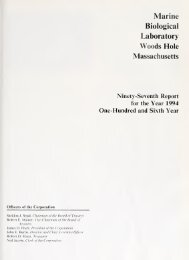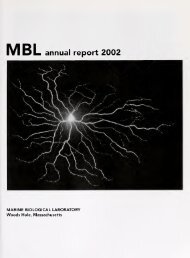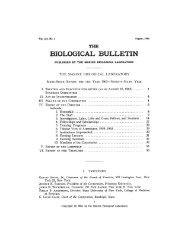View/Open - HPS Repository - Arizona State University
View/Open - HPS Repository - Arizona State University
View/Open - HPS Repository - Arizona State University
- No tags were found...
You also want an ePaper? Increase the reach of your titles
YUMPU automatically turns print PDFs into web optimized ePapers that Google loves.
46 researchlaboratory of aquatic biomedicineSENIOR SCIENTISTCarol L. ReinischASSISTANT RESEARCHSCIENTISTRachel CoxPOSTDOCTORALSCIENTISTJill KreilingVISITING INVESTIGATORRaymond Stephens,Boston <strong>University</strong>Our goal is to use marine animals as biomedical models. Wehave explored mechanisms of neurotoxicity using surf clamembryos (Spisula solidissima). We have discovered that a mixtureof chemicals found in polluted wells in Brick, New Jersey, causesan increase in an enzyme critical for neuronal development. Byfocusing on the p53 gene family, we have proven that p73 (notp53) may be exclusively expressed by Spisula neurons. Whetheror not p73 is a molecular target of environmental neurotoxinsremains to be determined.In our second model, we define the impact of environmentalcontaminants on a leukemia developed by blue mussels (Mytilusedulis). In collaboration with Environment Canada, we havediscovered that industrial chemicals plus untreated human wasteresults in much higher levels of leukemia throughout a pollutedharbor in Pictou, Nova Scotia. We have also discovered leukemiain Mytilus trossolus in Vancouver Harbor, British Columbia.We use both molecular and cellular assays to determine thelevel of toxicity and carcinogenicity in these molluscan species.Currently we are examining mechanisms of action using zebrafishembryos where more powerful and accurate probes are availablefor our research.PublicationsDewilde, S; Ebner, B;Vinck, E; Gilany, K;Hankeln, T; Burmester,T; Kreiling, J; Reinisch,C; Vanfleteren, JR;Kiger, L; Marden, MC;Hundahl, C; Fago,A; Van Doorslaer, S;Moens, L. 2006. Thenerve hemoglobin of thebivalve mollusc Spisulasolidissima: Molecularcloning, ligand bindingstudies, and phyogeneticanalysis. J Biol Chem 281:5364-5372.Muttray, AF; Cox, RL;St-Jean, S; van Poppelen,P; Reinisch, CL; Baldwin,SA. 2005. Identificationand phylogeneticcomparison of p53 intwo distinct musselspecies (Mytilus).Comp. Biochem. Physiol.C140(2): 237-250.St-Jean, SD; Stephens,RE; Courtenay, SC;Reinisch, CL. 2005.Detecting p53 familyproteins in haemocyticleukemia cells of Mytilusedulis from PictouHarbour, Nova Scotia,Canada. Can. J. FisheriesAquatic Sci. 62(9): 2055-2066.
















